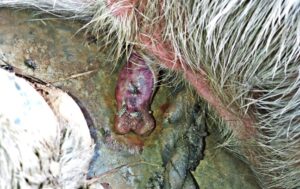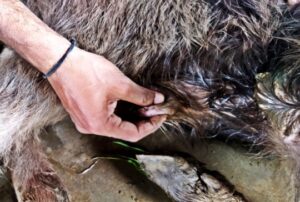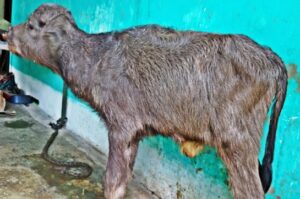Navel Ill in Calf: A Case Study
Aayush Yadav1*, Jagmohan Singh Chandrakar2, Vandana Bhagat3, Komal Chandraker4 and Jyotimala Sahu5
1Veterinary Assistant Surgeon, Sirpur, Mahasamund, Chhattisgarh
2Veterinary Assistant Surgeon, Tumgaon, Mahasamund, Chhattisgarh
3Assistant Professor, Department of Livestock Production and Management, College of Veterinary Science & Animal Husbandry, DSVCKV, Durg, Chhattisgarh
4Veterinary Assistant Surgeon, Fingeshwar, Gariyaband, Chhattisgarh
5Ph.D. Scholar, Department of Livestock Production and Management, National Dairy Research Institute, Karnal, Haryana, India
*Corresponding Author’s Email Id: aayush.aayush091@gmail.com
Summary: A 4-day old female Murrah calf was presented to the veterinary hospital, Sirpur, Mahasamund (C.G.) with symptoms of navel ill. Navel ill is a condition in the umbilicus characterized by inflammation as a result of infection of bacterial origin. The calf was treated with streptopenicillin, meloxicam, and nitrofurazone ointment for 5 days along with a regular dressing of the wound. The line of treatment showed a remarkable improvement in the health of the calf. It is recommended to adopt hygienic measures in the initial days of life of the calf to reduce the occurrence of navel ill.
Introduction: A bacterial disease of young calves, especially less than 1-week of age, occurring due to the infection entering via the umbilical cord at the time of birth or soon after birth is navel ill or omphalitis. The navel ill is a local infection with a prevalence of 5-15% in newborn calves. Calves that are untreated for navel ill may spread the infection from the navel to other parts of the body, generally joints, via the bloodstream, causing joint ill. Joint ill is a generalized infection. The eyes, heart, brain, kidney, and liver are the other sites of infection. Few deaths have been reported in the latter cases due to the poor metabolism rate, as a result of septicaemia, meningitis, and abscesses in the liver and kidneys. The infection gives birth to a variety of symptoms depending on the location of the bacteria.
If the infection persists mostly in the navel region, the calves are presented with a swollen, painful, and moist navel, depressed appetite, and high temperature sometimes, following which an abscess may develop containing thick custard-like pus. The calf must be treated at this stage. The calf left untreated develops inflammation in joints, characterized by swelling, pain, and stiffness in joints. Besides, the calf shows less tendency to move. Such conditions prevail when the calf is born or kept in unsanitary conditions like places having dung or fly menace. The real cause is E. coli causing abscesses in internal organs, septicaemia, and sudden death of animals.
| A case study: A female buffalo calf of approximately 30 kg was presented to the veterinary hospital, Sirpur, Mahasamund (C.G.) with swollen, painful, moist navel and inappetence. The calf was alert at the time of presentation. On history taking, it was found that the calf was born 04 days ago to a Murrah buffalo and that the calf was kept in a place frequently wet with rains, giving rise to unhygienic conditions. The owner further did not deny the menace of flies in the place. The calf was observed showing very little interest in the movement and had a body condition score of 2.0 out of 5.0. On physical examination, the calf was found to have a higher body temperature (pyrexia) of 103.2°F. The respiration and pulse rates were near to the normal range. The mucus membrane colour was pink and did not show any signs of anaemia. Simultaneously, on palpation of the navel region, pus formation (abscess) was noticed. Based on the symptoms, the calf was diagnosed with the navel ill disease and treated with the following medications. |  |
| Fig: Menace of flies on umbilicus | |
 |
|
| Fig: Abscess in navel | |
| Treatment:
1. A small incision was made aseptically at the site of pus formation (closed abscess) to drain the pus and remove the caseous material. The site was then washed with 1% KMnO4 solution and painted with tincture of iodine, and left open to dry. 2. An intramuscular injection of streptopenicillin 1.2 ml (1.0 ml/ 25 kg body weight) was administered to the calf once daily for 5 days. |
 |
| Fig: Navel ill in buffalo calf |
- An intramuscular injection of meloxicam and paracetamol 3.0 ml (1.0 ml/ 10 kg body weight) was administered to the calf once on day 1.
- On the subsequent day, pus was drained again, and the wound was washed with 1% KMnO4 solution and smeared with nitrofurazone ointment. The dressing of the wound was continued for the next 4 days.
- The combination of meloxicam and paracetamol injection was replaced with an intramuscular injection of meloxicam 3.0 ml (1.0 ml/ 10 kg body weight) for the next 4 days.
- The wound was sprayed with Topicure spray to prevent the infestation of maggots, bacterial and fungal growth, and check the fly menace.
- A multivitamin injection with liver extract, Bovoplex-cc, was injected intramuscularly @ 5 ml in alternate days up to the 5th day of treatment to increase the metabolism and appetite.
- A tremendous improvement in the health of the calf was noticed after 5 days of treatment with the swelling subsiding and wound showing granulation. The calf developed a good appetite for milk and started showing movements.
- In some cases, maggots may also develop in the wound and should be treated with the removal of maggots manually following simultaneous use of turpentine oil. Later, washing with 1% KmNO4 solution and packing the wound with a turpentine oil gauge should be done. On the subsequent day, cleaning of the wound with hydrogen peroxide and application of ointment should be carried out. The medications as discussed above will remain the same.
Prevention: Navel ill can be prevented through the following management practices.
- Make sure the calf is born in a clean hygienic environment.
- Cut the navel cord soon after the birth leaving 2-3 inches from the stalk, and dip it in a 7% tincture of iodine.
- Provide dry clean bedding to the calf.
- Provide an adequate amount of colostrum to the calf as early as within 1 hour of birth and twice to thrice daily. Provide colostrum to the calf @ 5-8% of its birth weight on the 1st day, and 10% on the 2nd and 3rd
- Repeated application of povidone iodine solution on navel cord should be carried out till it dries.
Conclusion: Navel ill is a condition in the umbilicus of young ones of usually less than 1-week of age, caused due to the bacterial infection, as a result of unhygienic conditions around the young ones and inadequate navel treatment. The umbilical management by removal of pus and caseous materials from a closed abscess, systemic antibiotic therapy using streptopenicillin, and topical antisepsis is effective in the treatment of navel ill. The owner is advised to maintain hygiene around the young ones and ensure adequate availability of colostrum to reduce the chances of navel ill.https://www.pashudhanpraharee.com/therapeutic-management-of-navel-ill-in-new-born-calf/
References:
- Mee, J. (2008). Prevalence and risk factors for dystocia in dairy cattle: A review. The Veterinary Journal, 176: 93-101.
- Faez, F., Muhammad, A.S., Konto, M., Abdulnasir, T., Abba, Y., Chung, E.L.T., Adamu, L., Osman, A.Y., Lila, M.A.M., Haron, A.W. and Saharee, A.A. (2015). A clinical case of navel and joint ill in a calf- Medical management. International Journal of Livestock Research, 5(5): 103-108.
- Naik, S.G., Ananda, K.J., Rani, B.K., Kotresh, A.M., Shambulingappa, B.E. and Patel, S.R. (2011). Navel ill in new born calves and its successful treatment. Veterinary World, 4(7): 326-327.
- (2021). Preventing navel ill. Washington State University. Assessed on October 24, 2021 at https://bit.ly/3vCZPPL.



